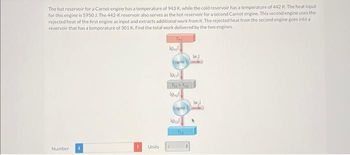Question

Transcribed Image Text:The hot reservoir for a Carnot engine has a temperature of 943 K, while the cold reservoir has a temperature of 442 K. The heat input
for this engine is 5950 J. The 442-K reservoir also serves as the hot reservoir for a second Carnot engine. This second engine uses the
rejected heat of the first engine as input and extracts additional work from it. The rejected heat from the second engine goes into a
reservoir that has a temperature of 301 K. Find the total work delivered by the two engines.
Number
1
Units
THI
lowl
Engine 1
local
J
Tel Tw
lokal
Engine 2
local
Tcz
#
lw
wal
Expert Solution
This question has been solved!
Explore an expertly crafted, step-by-step solution for a thorough understanding of key concepts.
This is a popular solution
Trending nowThis is a popular solution!
Step by stepSolved in 3 steps

Knowledge Booster
Similar questions
- A heat engine takes 1800 kcal of heat from a hot reservoir at 270oC and vents 1200 kcal to a cold reservoir at 40oC. What is the efficiency of this heat engine and what is the maximum efficiency that any heat engine between these two reservoirs could have?arrow_forwardThe hot reservoir for a Carnot engine has a temperature of 938 K, while the cold reservoir has a temperature of 362 K. The heat input for this engine is 7110 J. The 362-K reservoir also serves as the hot reservoir for a second Carnot engine. This second engine uses the rejected heat of the first engine as input and extracts additional work from it. The rejected heat from the second engine goes into a reservoir that has a temperature of 213 K. Find the total work delivered by the two engines.arrow_forwardA heat engine operates between a hot reservoir at 500°C and a cold reservoir at 25°C. It has an efficiency of 40%. Calculate the amount of heat absorbed from the hot reservoir when the engine expels 1500 J of heat to the cold reservoir.arrow_forward
- A particular power plant operates with a heat-source reservoir at 350°C and a heatsink reservoir at 30°C. It has a thermal efficiency equal to 55% of the Carnot-engine thermal efficiency for the same temperatures. What is the thermal efficiency of the plant? To what temperature must the heat-source reservoir be raised to increase the thermal efficiency of the plant to 35%? Again, η is 55% of the Carnot-engine valuearrow_forwardCopy of A heat engine is used to convert heat into work. If it draws heat from a bath at 500 K, converts it to work, then delivers the remaining heat into a bath at 300 K, what is its maximum possible efficiency? 20% 30% 40% 60% 70% 80% O O O O Oarrow_forwardProblem 2: This problem compares the energy output and heat transfer to the environment by two different types of nuclear power stations—one with the normal efficiency of 36 %, and another with an improved efficiency of 47 %. Suppose both have the same heat transfer into the engine in one day, 2.5 × 1014 J Part (a) How much more electrical energy is produced by the more efficient power station? Part (b) What is the change in the heat transfer to the environment after the upgrade to the more efficient power station?arrow_forward
- A steam boiler has a total volume of 4 m3. The boiler initially contains 3 m3 of liquid water and 1 m3 of equilibrium steam at 0.1 MPa. The boiler is turned on and heat is transmitted to the water and steam. Meanwhile, the inlet and outlet valves of the boiler remain closed. The safety valve escapes when the pressure reaches 5 MPa. How much heat is transmitted to the water and steam before I open the safety valve?arrow_forwardA high temperature reservoir losing heat and hence entropy is a reversible process. A low temperature reservoir gaining a certain amount of heat and hence entropy is a reversible process. But a high temperature reservoir losing heat to a low temperature reservoir is irreversible. Why?arrow_forwardA Carnot heat engine has an efficiency of 0.600. If it operates between a deep lake with a constant temperature of 288.0 K and a hot reservoir, what is the temperature of the hot reservoir? O 768 K O 480 K O 461 K O 720 Karrow_forward
- A sealed piston-cyclinder system contains 1.6 moles of helium (a monatomic ideal gas) at 1.6 atm pressure. An isothermal process is carried out in which 870 J of heat is transferred out of the system. Which one of the following statements is true? The process is described is impossible because no heat transfer occurs during an isothermal process. The internal energy of the system decreases by 870 J. 870 J of work is done on the system. Zero work is done. 870 J of work is done by the system.arrow_forwardThe first law of thermodynamics, ΔU = Q - W, when written as Q = W + ΔU, says that the heat into a system can be used to do work and/or increase the internal energy. Therefore, which process requires the most heat? Isobaric, isochoric, or adiabatic?arrow_forward
arrow_back_ios
arrow_forward_ios